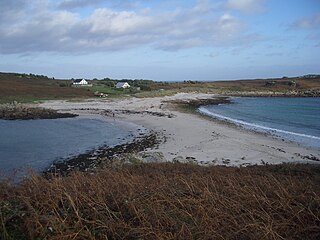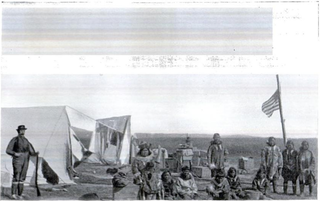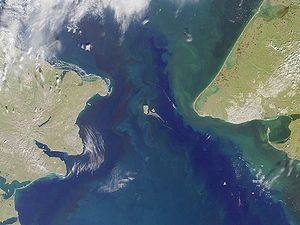
Unalaska is the chief center of population in the Aleutian Islands. The city is in the Aleutians West Census Area, a regional component of the Unorganized Borough in the U.S. state of Alaska. Unalaska is located on Unalaska Island and neighboring Amaknak Island in the Aleutian Islands off mainland Alaska. The population was 4,376 at the 2010 census, which is 79% of the entire Aleutians West Census Area. Unalaska is the second largest city in the Unorganized Borough, behind Bethel.

In oceanography, geomorphology, and earth sciences, a shoal is a natural submerged ridge, bank, or bar that consists of, or is covered by, sand or other unconsolidated material, and rises from the bed of a body of water to near the surface. Often it refers to those submerged ridges, banks, or bars that rise near enough to the surface of a body of water as to constitute a danger to navigation. Shoals are also known as sandbanks, sandbars, or gravelbars. Two or more shoals that are either separated by shared troughs or interconnected by past or present sedimentary and hydrographic processes are referred to as a shoal complex.

Umnak is one of the Fox Islands of the Aleutian Islands. With 686.01 square miles (1,776.76 km2) of land area, it is the third largest island in the Aleutian archipelago and the 19th largest island in the United States. The island is home to a large volcanic caldera on Mount Okmok and the only field of geysers in Alaska. It is separated from Unalaska Island by Umnak Pass. In 2000, Umnak was permanently inhabited by only 39 people.
Smoky Point is a point of land in the U.S. state of Alaska, located at 57°36′44″N157°41′24″W, where Ugashik Bay joins the much larger Bristol Bay. The most easily distinguishable landmark is the United States Coast Guard lighthouse which is visible to mariners on the eastern shore of Bristol Bay and all of Ugashik Bay.

The Egegik River is a waterway in the U.S. state of Alaska. A biological survey was conducted at the base of the Alaska Peninsula in 1902 by Wilfred Hudson Osgood, which included the Egegik River.

Providence Bay is a fjord in the southern coast of the Chukchi Peninsula of northeastern Siberia. It was a popular rendezvous, wintering spot, and provisioning spot for whalers and traders in the nineteenth and early twentieth centuries. Emma Harbor is a large sheltered bay in the eastern shore of Providence Bay. Provideniya and Ureliki settlements and Provideniya Bay Airport stand on the Komsomolskaya Bay. Plover Bay in English sources sometimes refers specifically to the anchorage behind Napkum Spit within Providence Bay but was commonly used as a synonym for Providence Bay; Russian 19th century sources used the term for an anchorage within Providence Bay.

Tautira Bay is located on the island of Tahiti in French Polynesia. It is part of the commune Taiarapu-Est. It is formed by Tautira Point and reef on the eastern side, and by the barrier reef on the western side. It is reached through a gap in the reef about half a mile wide, with deep water, with Tautira point giving it protection from winds from north-east. It is 0.5 miles (0.80 km) wide and about the same depth. The bay opens to the northwest, affording protection with winds from northeastward through east and south to west-northwestward, but can be dangerous with those between north and west-northwestward. James Cook anchored several times in this bay, from which circumstance the name is derived. The depth in the middle of the entrance is from 35 to 60 fathoms, diminishing gradually to the shore. The bay is clear, except a small patch of 2 fathoms 600 feet (180 m) southward of the point of reef on the western side. The eastern and southeastern shore is lined with a sandy beach. The best anchorage is at about 1,200 feet (370 m) from the shore in 8.5 fathoms, sand, with the extreme of Tautira Point bearing 45°.

Murder Cove is located at the southernmost portion of Admiralty Island in the U.S. state of Alaska. The cove was home to the Tyee Company whaling station and was known for whaling operations from 1907 through 1913.

Tongass Narrows is a Y-shaped channel, part of Southeast Alaska's Inside Passage. The waterway forms part of the Alaska Marine Highway and as such, is used by charter, commercial fishing, and recreational vessels, as well as commercial freight barges and tanks, kayaks and passenger ferries.
The Bob Blodgett Nome-Teller Memorial Highway, also known as the Nome-Teller Highway, but generally referred to as simply the Teller Highway, is a well-maintained gravel road in Alaska. It runs 72 miles northwest from Nome to the Inupiat village of Teller, located at the base of the sand spit that divides Port Clarence from Grantley Harbor.

Nepean Bay is a bay located on the north-east coast of Kangaroo Island in the Australian state of South Australia about 130 kilometres south-south-west of Adelaide. It was named by the British navigator, Matthew Flinders, after Sir Evan Nepean on 21 March 1802.

Teller Reindeer Station was located near Teller in the U.S. state of Alaska. The idea of transporting domestic reindeer from Siberia to western Alaska was first suggested by Captain Michael A. Healy, an officer in the United States Revenue Cutter Service, as a possible solution to the Native Alaskans' food shortage problem. The station was established in 1892 by Sheldon Jackson, Commissioner of Education in Alaska and a Presbyterian minister, who named it in honor of Henry M. Teller. The U.S. Government's Alaska Reindeer Service program ended in the early 1900s.

Isanotski Strait is a strait connecting the northern Gulf of Alaska with the Bering Sea, in the U.S. state of Alaska. Isanax̂ is the Aleut name for present day Isanotski Strait, and means gap, hole, rent, or tear in the Aleut language which was rendered as Isanotski in transliterated Russian. The strait appears as Исанакъ in 1802 and Исаноцкый in 1844 on Russian maps.

Ikatan Bay is a waterway in the U.S. state of Alaska. The bay and Isanotski Strait separate Unimak Island from the Alaska Peninsula. They have been used by light-draft craft, intended for service on the Yukon River, in making the passage from Puget Sound ports to St. Michael.

The Fox Islands Passes are waterways in the Fox Islands area of the U.S. state of Alaska, connecting the Bering Sea with the North Pacific Ocean.

Unalaska Bay is a waterway of Unalaska Island in the U.S. state of Alaska. It is situated below the eastern slopes of Makushin Volcano. Composed of seven individual bays, Unalaska Bay opens onto the Bering Sea.

Cape Kalekhta is a headland on the northeast coast of Unalaska Island in the U.S. state of Alaska.

Germein Bay is a bay in the Australian state of South Australia located at the northern end Spencer Gulf on the gulf’s east coast to the immediate north of the city of Port Pirie. Its extent includes the port known as ‘Port Pirie’ and the former port of Port Germein. Since 2012, the majority of the bay has been within the protected area known as the Upper Spencer Gulf Marine Park.
American Bay is a waterway on Dall Island in the U.S. state of Alaska.



















